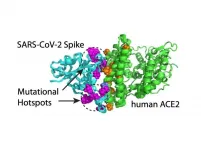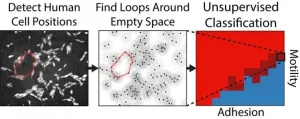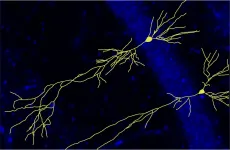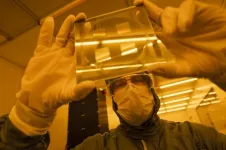(Press-News.org) SARS-CoV-2 has evolved to acquire mutations on the spike protein--the part of the virus that protrudes from its surface and latches onto cells to infect them--that enhance the coronavirus' ability to bind to human cells or evade antibodies. A new study from the Centers for Genomics and Systems Biology at New York University and NYU Abu Dhabi uses computational modeling to assess the biological significance of spike protein mutations, uncovering versions of the virus that bind more tightly or resist antibodies and offering a promising public health surveillance tool.
The study, which appears in the Journal of Molecular Biology, also suggests that these mutations on the spike protein are a key reason for the virus' rapid spread in parts of the world.
New and more transmissible COVID-19 variants have emerged in recent months, fueling surges of cases in countries like India and Brazil. As a public health measure, rapid surveillance methods are needed to determine the biological effects of variants and to help anticipate emerging infectious viral strains. But monitoring new variants is no small task; genome sequencing shows that the SARS-CoV-2 spike protein alone, for example, has about 5,000 possible variants.
"Screening such a large set of variants poses a tremendous challenge for conventional experimental methods," said Hin Hark Gan, a senior research scientist at NYU's Center for Genomics and Systems Biology and the study's lead author. "An advantage of computer-based modeling is that a hundred mutations can be readily assessed in a few days."
Gan and his colleagues turned to a computational method that models how the SARS-CoV-2 spike protein recognizes the ACE2 receptor--a protein on the surface of many types of cells--to gain entry into host cells. Studies of coronaviruses indicate that spike-ACE2 recognition is the basis for infection.
The researchers focused on screening the mutations located where the spike protein and ACE2 receptor meet. They assessed 1,003 mutation combinations in the spike and ACE2 proteins, including those resulting in the fast-spreading spike variants that have originated in Brazil, South Africa, the U.K., and India.
Their systematic assessment of variants uncovered that spike mutations that bind tightly to the ACE2 receptor occur in two clusters or mutation "hotspots" on the binding interface. These hotspots are located in structurally flexible regions, indicating that mutations that increase binding effectively reprogrammed the spike conformation to enhance its recognition of the ACE2 receptor.
The researchers also looked at single, double, and triple mutations in the critical spike interface region, which make up some of the recently emerged infectious variants. Their modeling analysis suggests the spike variants S477N, N501Y, and S477N + E484K and E484K + N501Y--fast-spreading double mutants found in Brazil, South Africa, the U.S., and U.K.--have increased binding to the ACE2 receptor relative to the original coronavirus that emerged in Wuhan.
Gan and colleagues observed that the E484K and E484Q mutations found in some recent fast-spreading variants are not only predicted to bind more strongly to ACE2 but have also been shown to confer antibody resistance. Neutralizing antibodies are produced in response to viral infection and target different sites on the spike protein to prevent the virus from invading host cells. This prompted the researchers to look at another factor contributing to viral transmission: antibody resistance of individual spike mutations.
In particular, the variant circulating in India has two mutations in the spike interface region: L452R and E484Q. This variant is not predicted to bind to the ACE2 receptor more tightly than the virus that originated in Wuhan, likely because the individual mutations have opposing effects (the L452R mutation binds less easily while the E484Q mutation binds more easily). Strikingly, however, both of these mutations are strong antibody evaders, a scenario not found in other recent variants.
"As more of antibody target sites become resistant to antibodies due to viral mutations, the efficacy of existing antibodies and vaccines may diminish," added Gan. "This scenario is a likely cause for the rapid spread of the variant in India."
The study not only provides explanations for the coronavirus' rapid spread--both mutations that enhance binding to human cells and help evade antibodies--but also points to a promising predictive tool in the ongoing public health fight against SARS-CoV-2.
"Our computational modeling method can be used as a real-time surveillance tool to screen for emerging infectious COVID-19 variants. It allows for a more timely response to emerging outbreaks and could be used to guide the development of new vaccines," said Kristin C. Gunsalus, professor of biology at NYU, faculty director of bioinformatics at NYU Abu Dhabi, and the study's senior author.
INFORMATION:
In addition to Gan and Gunsalus, study authors include Alan Twaddle in the Gunsalus group at NYU and NYU Abu Dhabi, as well as Benoit Marchand in NYU Abu Dhabi's High Performance Computing Group.
Press release - ESE statement: COVID-19 and endocrine and metabolic diseases. An updated statement from the European Society of Endocrinology
New expert statement confirms strong links between our hormones and COVID-19
The endocrine system is strongly involved in SARS-Cov-2 infection - so much so that evidence of an "endocrine phenotype" of COVID-19 has emerged, according to a statement by the European Society of Endocrinology (ESE) published in the journal Endocrine in April 2021. Leading endocrinology researchers looked into the evidence that has accumulated over the past year since the pandemic emerged, and consistently found evidence ...
PROVIDENCE, R.I. [Brown University] -- The field of mathematical topology is often described in terms of donuts and pretzels.
To most of us, the two differ in the way they taste or in their compatibility with morning coffee. But to a topologist, the only difference between the two is that one has a single hole and the other has three. There's no way to stretch or contort a donut to make it look like a pretzel -- at least not without ripping it or pasting different parts together, both of which are verboten in topology. The different number of holes make two shapes that are fundamentally, inexorably different.
In recent years, researchers have drawn on mathematical topology to help explain a range of phenomena like phase transitions in matter, aspects of Earth's climate and even how zebrafish ...
One-quarter to one-third of young, active patients who undergo anterior cruciate ligament reconstruction experience a second ACL injury after they return to sport (RTS). New research indicates that young athletes who feel confident about their knee health at the time of medical clearance for sports participation after ACL surgery have a higher likelihood of meeting all RTS criteria related to physical function but also have a higher likelihood of experiencing a second ACL injury within 2 years after RTS.
The study, which included 159 participants with an average age of 17 years, is published in the Journal of Orthopaedic Research.
"These data suggest that as health care providers, we may need to re-evaluate the tools we currently use to determine readiness to return ...
The rhythmic motions of hair-like cilia move liquids around cells or propel the cells themselves. In nature, cilia flap independently, and mimicking these movements with artificial materials requires complex mechanisms. Now, researchers reporting in ACS Applied Materials & Interfaces have made artificial cilia that move in a wave-like fashion when a rotating magnetic field is applied, making them suitable for versatile, climbing soft robots and microfluidic devices. Watch a video of the artificial cilia here.
Replicating movements found in nature -- for example, the small, whip-like movements of cilia -- could ...
While the APP protein is well-known for its key role in Alzheimer's disease, its contribution to healthy brain function, by contrast, has remained largely unknown until now. Recently, an international research team, led by molecular biologist Prof. Dr Ulrike Müller from Heidelberg University, gained new insights on the physiological functions of the APP protein family by using a mouse model lacking APP. The absence of APP during brain development was shown to result in the malformation of important brain regions implicated in learning and memory. Consequently, these mice were severely impaired in their learning abilities and exhibited autistic-like ...
In an article published in the International Journal of Mental Health Nursing, experts stress that the COVID-19 pandemic presents the "perfect storm" for family violence, where a set of rare circumstances have combined to aggravate intimate partner violence, domestic abuse, domestic violence, and child abuse.
Factors during the pandemic that have come together to contribute to family violence may include increased stress and trauma, economic hardship, imposed isolation, and decreased access to community and faith-based support.
The authors note that public health officials and mental health professionals need to be aware of the impact of disasters on family violence, and they should strive to identify those at risk and provide ...
Individuals are often prescribed increasing numbers of medications as they age, and while many of these prescriptions are justifiable, some may be inappropriate. A recent analysis published in the British Journal of Clinical Pharmacology examined the results of all studies investigating associations between potentially inappropriate prescribing--which includes prescribing medications that may not produce benefits relative to harm and not prescribing medications that are recommended--and outcomes of older adults.
Potentially inappropriate prescribing was significantly associated with a range of health-related and system-related outcomes, including functional decline, falls, ...
By the end of the first year of the pandemic in metropolitan Stockholm, investigators estimate that one-fifth of adults in the region previously had COVID-19. The findings, which are published in the Journal of Internal Medicine, come from analyses of anti-viral antibody responses in healthy blood donors and pregnant women.
For the study, researchers examined blood from 2,600 blood donors and 2,500 pregnant women taken between March 14th 2020 and February 28th 2021. Blood donors and pregnant women had a similar rate of past infection, approaching 19% of the study group by the end of February 2021, shortly ...
Monash University researchers have engineered new antimicrobial surfaces that can significantly reduce the formation of bacteria on medical instruments, such as urinary catheters, and reduce the risk of patient infection while in hospital.
This world-first study demonstrates the potential for 3D engineered surfaces in preventing the initial formation of microcolonies of Escherichiacoli (E.coli), Klebsiellapneumoniae and Pseudomonas aeruginosa - the three most common urinary tract bacterial infections (UTIs) associated with catheters.
The study team, led by Dr Victor Cadarso, from Monash University's Department of Mechanical and Aerospace Engineering and the ...
SALT LAKE CITY - A new study published in the Journal of Clinical Oncology reports findings on Huntsman at Home™, a cancer hospital-at-home model operated by Huntsman Cancer Institute (HCI) at the University of Utah (U of U). The study analyzed aspects of Huntsman at Home acute care--meaning a level of care that is generally provided in an inpatient hospital setting.
In the 30 days after study entry, Huntsman at Home participants had 55% fewer hospitalizations, 45% fewer emergency department visits, and shorter hospital stays by one day. They also had 47% lower health care costs during the same 30-day period ...





